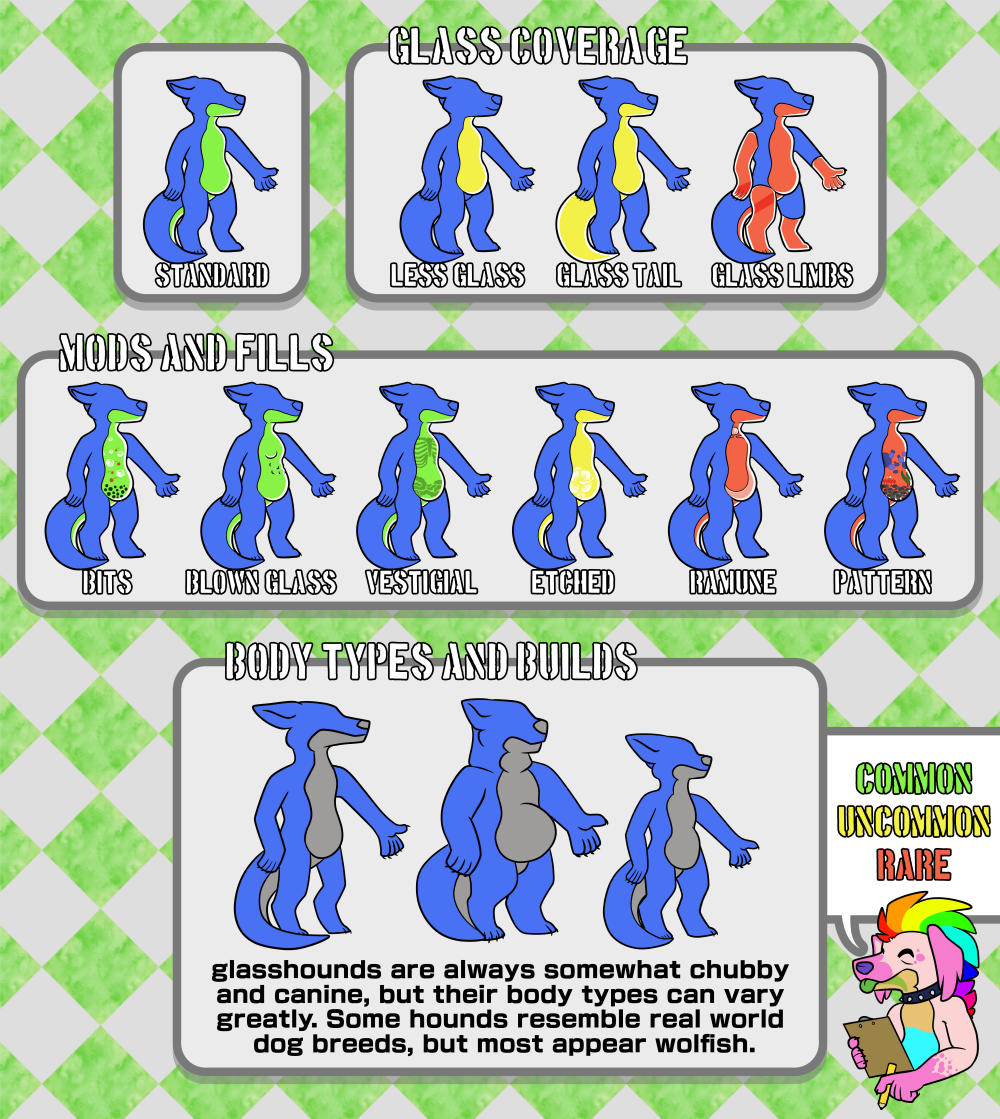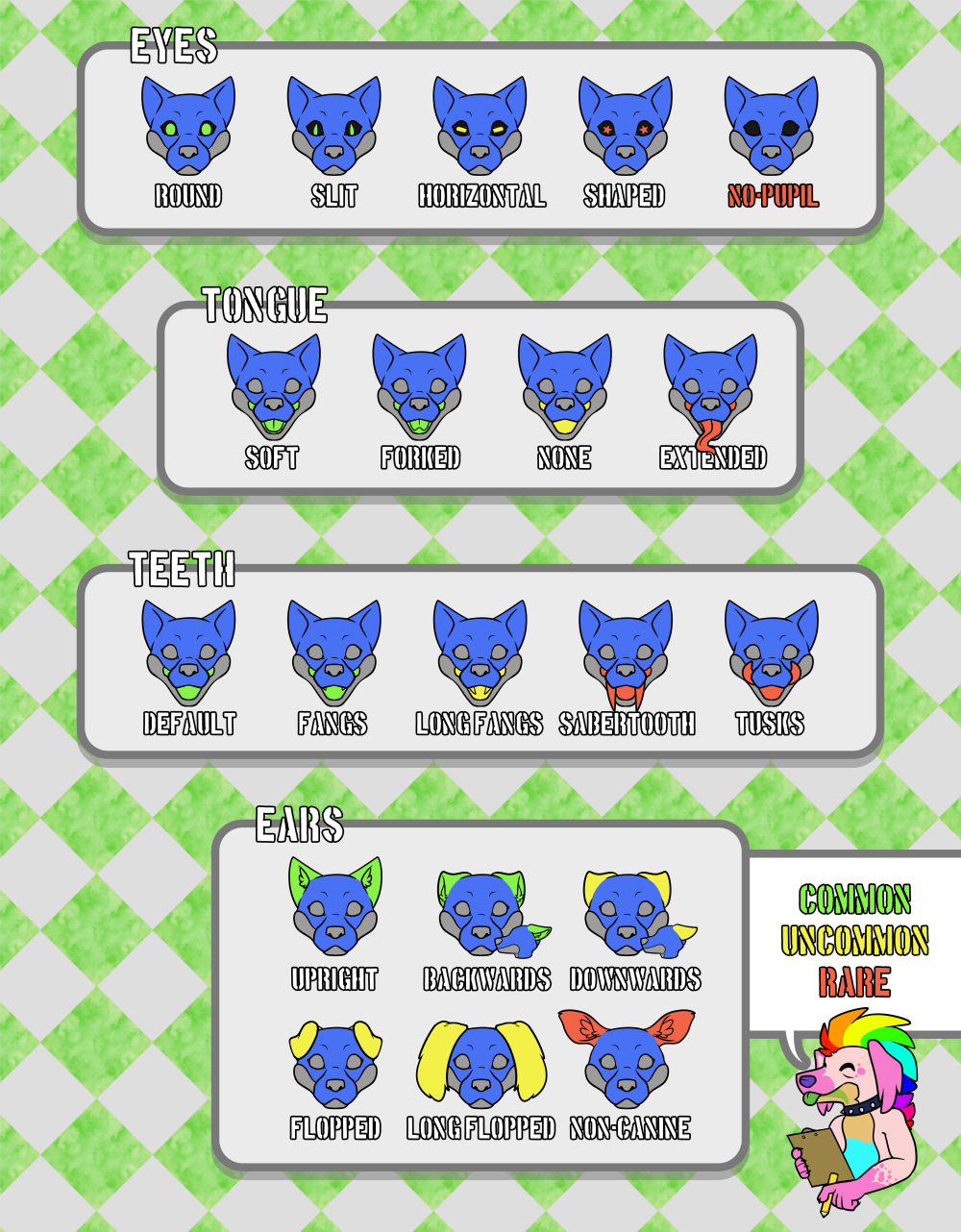Until this is complete and formatted, all trait sheets can be found on DeviantArt.

This is a rough guide showing the most likely locations for a Glasshounds fur to grow in length. Areas not marked with a rarity guide almost never see fur growth from their coat alone.
Thicker fur located on their ears, cheeks, shoulders, elbows and sometimes on the tips of their tails. Their fur is much more dense than standard and extremely soft.
Long wispy fur grows from the cheeks, elbows and along their tails. It is quite delicate and tends to tangle easily.
A default coat for glasshounds is short fur with minimal amounts of fluff in their ears. It is smooth to the touch, and relatively thin.
The shorter fur on their cheeks, ears and shoulders have a distinct upward curl. The longer fur on their tail, located at the base and the tip, has a much wavier appearance.
An extremely long and dense coat, often regarded as a hindrance in daily life. Unlike most other types of glasshound fur it can affect the entire body.
A fringe of longer fur around their ankles. Can get quite long and needs frequently groomed.
A poof of short. dense fur at the end of their tails. Can look like a lions tail tip, or a poodle cut puff.
A pair of non-functional feathered wings, never get very large but can be extremely stylized.
A trail of fur that hangs down from the shoulders.
It can optionally cover over the shoulders for a poncho look, and length varies greatly.
Thicker fur that grows up from their fingertips. Can range from their wrists all the way to just past their elbows.
A ring of longer fur from the hips, can range from just below the hips to just past their ankles.
A ridge of fur that runs down their back. Always goes down to the base of the tail at minimum.
Furred flaps of skin that resemble that of a flying squirrel, do not actually help with gliding at all.
Long fur that starts roughly from the base of their tail.
It will always go past their knees in length but be long enough it drags behind them.
At first glance it resembles hair, but is in fact stiff enough to stand straight up. Will never go past mid-back in length.

The default appearance for a Glasshound, with no glass variance or modifications.
As these traits are all optional, this is what a Hound will look like if none of the following traits are chosen.
Up to 50% less glass visible, most commonly shows in tail or throat.
This trait makes it so the entire tail is made from the glass material.
This allows the presence of one or two glass limbs. It can be both arms, both legs, or one of each. Coverage can range from the hip/shoulder to their knee/elbow and does not have to be the same on both limbs. All four limbs can be present with the use of a second rare trait.
If it can be found in a drink, you might find it in a Glasshound. Can be ice cubes, cherries, or anything in between.
Free floating organs or bones within the stomach. They are not attached, and serve no purpose. Most commonly ribs or guts.
A thicker layer of glass within the hounds stomach that support a marble in their throat. The marble cannot be removed.
A technique of heating their glass and forming it, usually into more defined chests or muscles. It does make the glass much more fragile.
Through use of outside tools, the surface of the glass is scratched to have either an artistic design or simply be slightly opaque.
Detailed patterns added to the surface of the glass, usually in bright opaque colours. Florals are the most popular design.

Glasshounds have black sclera and what appear to be coloured pupils, with no visible iris.
You're normal round pupils, standard dog eye.
Pupil is a horizontal line, similar to a horse.
Despite the lack of pupil, somehow these glasshounds are still capable of seeing.
A vertical slit, much like a cat in bright light.
Pupils take on a shape not found in any animal, could be star shaped, spirals or flowers.
The normal tongue is round and attached to the inside of their capsule.
As it serves little benefit to the hound, some have no tongues at all.
Similiar to a reptile, the tip of their tongue is split down the middle.
Small teeth that are not visible below the lips. Closest to your standard dog.
Long and thin canines that are easily visible but still fit inside their mouth. They are almost like needles in sharpness.
Slightly longer than average canines. Only just peak out below the top lip.
Extremely long canines that even with a closed mouth rest outside. Despite looking quite sturdy are actually quite fragile.
Medium sized triangular ears that point upwards.
Medium sized triangular ears that point back and towards the ground.
Ears that stick up slightly before falling over, can be paired with either of the common ears for one flopped and one not.
Medium sized triangular ears that point behind them and slightly to the side.
These ears do not stick up at all, and instead droop immediately due to their length.
Any ear not present on a canine species, be it bear, horse or deer.